Techniques for Evaluating Surface Finish in Manufacturing
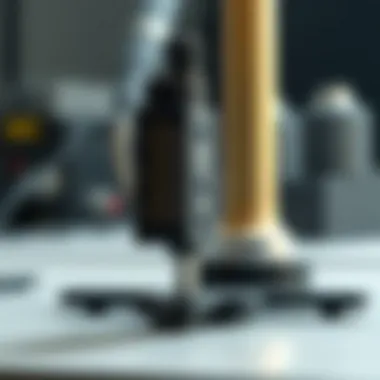
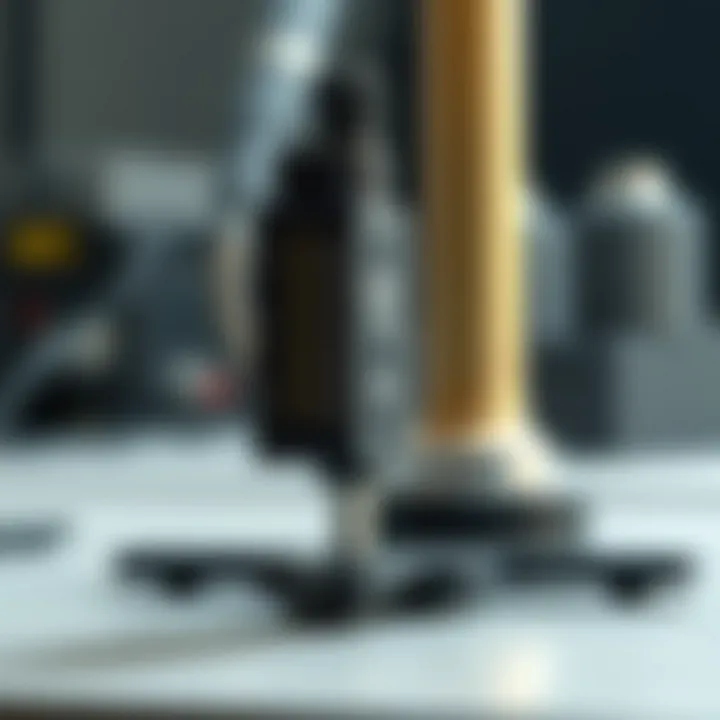
Intro
In the world of manufacturing, the surface finish of a product is like the icing on the cake— it can make the difference between a functional item and one that achieves its full potential in performance. When engineers and designers discuss surface finish, they refer to the texture and cleanliness of a material's surface, which subsequently impacts everything from durability to aesthetic appeal.
As modern industry evolves, measuring surface finish has become crucial. Various techniques have emerged, each with unique advantages and challenges, catering to diverse applications across sectors. In understanding these methods, researchers and professionals can navigate the intricacies of both traditional and contemporary techniques, ensuring that they select the appropriate one based on specific production needs.
This comprehensive guide delves into a range of methodologies utilized for assessing surface finish. From tactile approaches to optical technologies, this article will unpack the principles, advantages, and limitations inherent in each method. Additionally, we’ll explore the implications these surface qualities have on material properties and the overall functionality of finished products. By the end of this article, students, engineers, and researchers will be well-equipped to tackle the critical task of measuring surface finish effectively.
Research Highlights
Key Findings
- Surface finish significantly affects mechanical properties like fatigue resistance and corrosion behavior.
- Automated techniques, like laser scanning, provide faster and more precise measurements than conventional methods.
- Comparative studies showcase that while traditional methods remain relevant, advancements in technology offer game-changing alternatives for complex geometries.
Implications and Applications
Understanding surface finish measurement techniques is of utmost importance in various fields, including aerospace, automotive, and medical device manufacturing. As industries push for higher standards and efficiency, the choice of surface finishing methods has broad implications for:
- Product lifespan and reliability
- Regulatory compliance in critical applications
- Customer satisfaction stemming from quality perception
Optimizing surface finish measurement translates into more effective design iterations, improved functional performance, and ultimately, a stronger competitive edge.
Methodology Overview
Research Design
This article synthesizes findings from empirical studies, expert interviews, and industry reports, synthesizing a practical perspective on surface finish methodologies. Each method is analyzed through lenses of effectiveness, practicality, and emerging trends.
Experimental Procedures
Different techniques will be discussed, including:
- Contact Profilometry: A technique that employs a stylus to measure surface height variations, providing a detailed profile.
- Optical Scanning: Utilizing laser technology to map surface features without physical contact, suitable for fragile materials.
- Atomic Force Microscopy: This method allows for incredibly precise measurements at the nanometer scale.
These methodologies are not merely technical choices; they serve as the backbone of quality assurance protocols in manufacturing processes. As we progress through the article, each section will unravel the depths of these techniques, summarizing how they align with modern manufacturing demands.
For insightful discussions on the influence of surface finish on product performance, check out Wikipedia's entry on the topic as well as relevant forums on Reddit for community-driven insights.
Preface to Surface Finish
Surface finish is more than just a technical detail; it represents a crucial aspect of how materials interact in real-world applications. To grasp this significance, one must consider the influence surface characteristics have on performance, durability, and aesthetic appeal. When engineers design components, they must account for surface finish to ensure that products not only function correctly but also meet stringent quality standards.
Take for example a burnished metal part. The degree of smoothness can affect not just its servicing longevity but also its wear resistance. In less obvious terms, surface finish can even impact how efficiently a mechanical part interacts with another, influencing friction, heat generation, and ultimately, product lifespan.
With the wide variety of materials and applications today, understanding surface finish helps bridge the gap between conceptual designs and practical usage. As markets become more competitive, the quality of finish may very well be the differentiator that positions one product ahead of another, especially in high-stakes industries like aerospace or automotive manufacturing.
Definition of Surface Finish
Essentially, surface finish refers to the texture and smoothness of a surface. Engineers often express it through parameters like roughness, waviness, and lay. Roughness quantifies the minor deviations of a surface, which can profoundly affect friction and wear, while waviness refers to more significant deviations that occur over a broader area. Lay, on the other hand, describes the pattern of surface texture, influenced by the production method used.
These attributes are not just esoteric concerns; they measurably impact applications from machinery components to electronic housings. For instance, in semiconductor fabrication, the smoothness of a silicon wafer is directly tied to its performance. Fine control over surface finish can also result in enhanced paint adhesion in automotive surfaces, contributing both to aesthetics and durability.
Importance in Engineering and Manufacturing
The importance of measuring and analyzing surface finish cannot be overemphasized. It permeates numerous fields, affecting quality control and compliance with industry standards. For example, in the aerospace sector, even the tiniest imperfections can lead to catastrophic failures. Therefore, detailed measurements can not only prevent costly errors but also ensure safety and reliability.
Moreover, as manufacturing techniques evolve, so do benchmarks for quality. Advanced techniques like laser scanning and optical interferometry have emerged, pushing the boundaries of what can be measured and how precisely.
Key reasons for prioritizing surface finish include:
- Performance Optimization: A suitable surface finish can enhance the operational effectiveness of components, ensuring smooth functionality.
- Product Lifespan: Materials with appropriately finished surfaces tend to resist wear and corrosion more effectively.
- Cost Efficiency: Sanding and polishing costs can escalate; hence, ensuring proper measurements upfront can avoid wasted resources.
- Customer Satisfaction: In consumer products, the surface finish often defines quality perception, contributing to brand loyalty.
To sum it up, surface finish is a silent force operating behind the scenes, yet its impact is vividly visible in the performance and reliability of engineering products.
Characteristics of Surface Finish
The characteristics of surface finish play a pivotal role in understanding how materials behave in various applications. The intricacies of surface finish influence not only the aesthetic appeal of a product but also its functionality, durability, and performance. Recognizing the parameters that define surface finish is essential for engineers and designers, as these factors directly impact manufacturing processes and the final product's success.
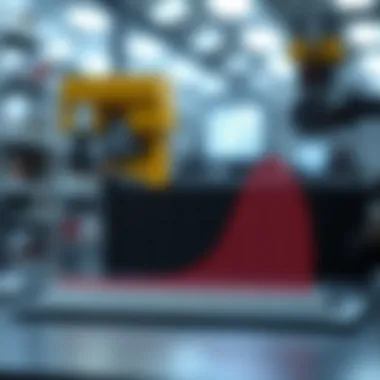
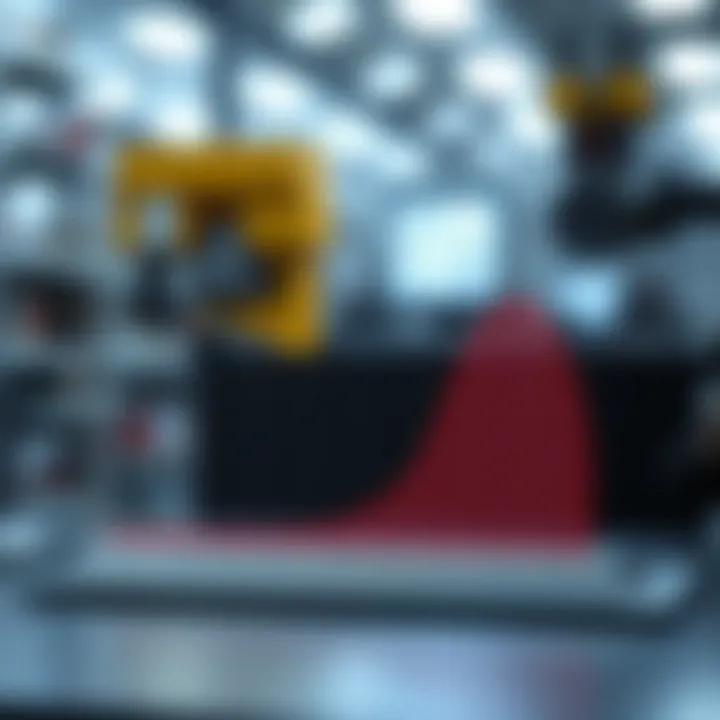
Roughness Parameters
Roughness parameters are perhaps the most commonly discussed traits of surface finish. These parameters quantify the small-scale deviations on a surface, offering a detailed view into its texture. Two primary roughness indices are often measured: Ra (arithmetic average roughness) and Rz (average peak-to-valley height).
- Ra: This parameter is a simple arithmetic mean of the deviations from the mean line. It provides quick insight but may not capture the finer peaks and valleys present on a surface.
- Rz: This metric looks at the average height of the five highest peaks and the five deepest valleys within a defined length, offering a more nuanced understanding of surface inconsistencies.
While these parameters help paint a picture of the surface's roughness, they can only go so far. For example, a surface might have a similar Ra value as another yet feel entirely different to touch. These subtle differences can make big waves in applications where friction and wear resistance are critical.
Waviness and Lay
Waviness and lay are two additional characteristics that contribute to a comprehensive understanding of surface texture. While roughness focuses on the fine details, waviness relates to the broader, more substantial fluctuations in surface height. This involves examining features that extend beyond just roughness; they can stem from the manufacturing process itself, like milling or turning.
Lay, on the other hand, refers to the directionality of the surface texture. Factors affecting lay include:
- Manufacturing methods: Processes like grinding and polishing can create different lay patterns.
- Post-processing: Treatments applied after initial machining can alter the lay significantly.
Understanding these factors is beneficial. For example, in automotive applications, a specific lay direction might be crucial for reducing noise or improving aerodynamics.
Defects and Anomalies
Lastly, recognizing defects and anomalies is essential when discussing characteristics of surface finish. Defects can include scratches, pits, or other unwanted marks that detract from the functional and aesthetic qualities of a surface. These imperfections can arise due to tooling issues, incorrect handling, or even material inconsistencies.
It’s worth noting common surface anomalies to watch out for:
- Micro-cracks: Often a result of stress or fatigue in materials.
- Rounding: The edges of a surface might become rounded due to wear, affecting its performance.
- Discoloration: This might result from chemical exposure or manufacturing processes, indicating a potential issue with the material integrity.
The influence of defects is substantial; even minor inconsistencies can lead to failure in critical applications. It’s a guiding principle in quality control to monitor these characteristics closely.
"Understanding these characteristics is not just academic; it's about ensuring reliability and safety in real-world applications."
Incorporating a clear view of these characteristics can significantly enhance the quality of production processes. With a solid grasp on the roughness parameters, waviness, lay, and potential defects, professionals can make informed decisions that elevate product performance across industries like aerospace, automotive, and electronics.
For further reading, refer to resources such as Wikipedia - Surface Finish, Engineering Toolbox, or academic articles available at Google Scholar.
Understanding surface finish characteristics isn't just knowledge—it's the cornerstone of material performance.
Contact-Based Measurement Techniques
In the realm of surface finish measurement, contact-based techniques represent a cornerstone approach. These methods involve direct contact with the surface being evaluated to gather information on its texture and characteristics. Despite the rise of advanced non-contact options, contact-based methods have maintained their significance due to their accuracy and robustness in various contexts.
The importance of contact-based techniques lies in their ability to provide precise and repeatable measurements. By utilizing tools that physically engage with the material, these methods capture intricate details of surface irregularities such as peaks and valleys. This level of detail is crucial in industries where even the minutest variations can lead to major impact on performance, such as aerospace and automotive manufacturing.
Profile Measurement
Profile measurement serves as a fundamental technique under the umbrella of contact-based methods. Essentially, it involves tracing a path across a surface and recording height variations to create a profile, revealing the surface's topography. These measurements can be performed using a stylus, which drags across the surface, or through other contact instruments. The output is a graphical representation of the surface, allowing for detailed analysis of features like roughness and waviness.
Key Elements of Profile Measurement:
- Surface Analysis: Identifies specific irregularities in texture.
- Data Interpretation: Facilitates a more nuanced understanding of surface attributes.
Stylus Profilometry
Stylus profilometry is a prime example of how profile measurement is implemented. This technique uses a fine stylus mounted on a mechanism that can move vertically and horizontally along the surface. As the stylus moves, it records vertical displacements, generating data that corresponds to the surface profile. The resolution and sensitivity of stylus profilometry allow for exceptional accuracy in capturing surface details.
However, it’s worth noting that the performance of stylus profilometry can be influenced by several factors including:
- Stylus Geometry: The shape of the stylus can affect measurement capabilities.
- Material Hardness: Certain materials may wear down the stylus or deflect it, influencing results.
- Speed of Measurement: Rapid movements can introduce errors, necessitating careful calibration.
Limitations of Contact Techniques
Despite their many benefits, contact-based measurement techniques do come with some limitations. One significant drawback is the potential for wear and tear on both the measurement device and the sample surface. Prolonged contact can alter the surface being measured, leading to inaccuracies over time.
Moreover, contact techniques often require meticulous setup and calibration, which can be time-consuming. Environmental factors, such as vibrations or temperature fluctuations, can also negatively impact the results.
Here are some points to consider regarding the limitations:
- Surface Damage: Risk of scratching or altering sensitive surfaces.
- Measurement Speed: Slower compared to non-contact methods.
- Material Limitations: Not all surface materials are suitable for contact measurement due to hardness or fragility.
In summary, while contact-based measurement techniques like profile measurement and stylus profilometry boast remarkable precision, users must remain cognizant of their limitations. The continuing development of surface finish measurement practices seeks to address these challenges, striving for improved accuracy and efficiency.
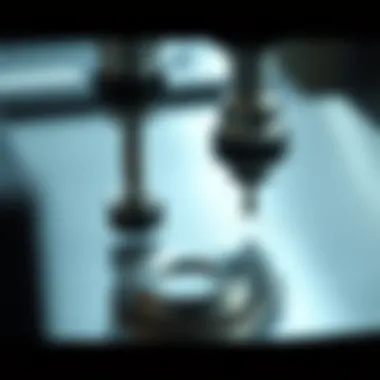
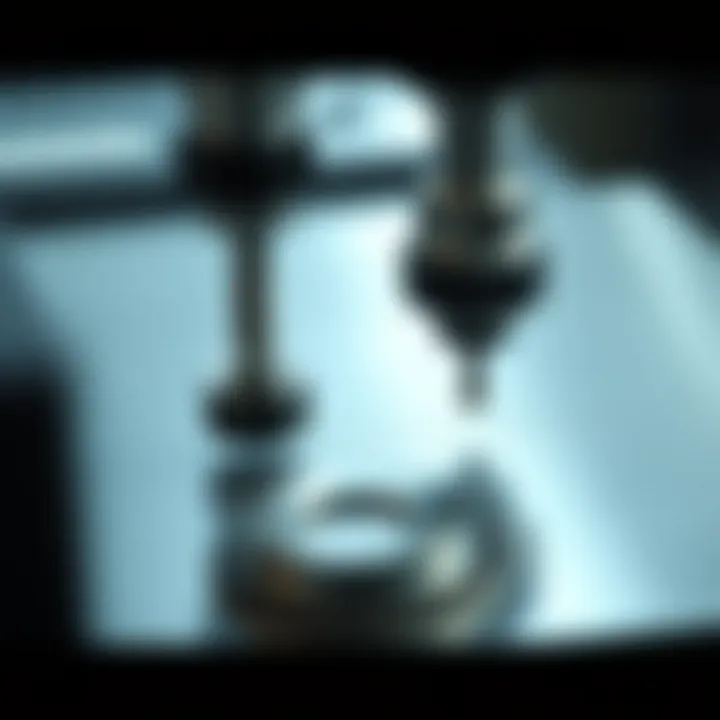
"The right choice of technique can prevent a world of hassle down the line. Choosing wisely ensures the integrity of results in surface finish analysis."
For further information, additional resources on surface finish measurement can be found at:
In closing, understanding the strengths and weaknesses of contact-based techniques is essential for industries that prioritize precision and quality in production.
Non-Contact Measurement Techniques
Non-contact measurement techniques have gained significant traction in the field of surface finish evaluation. These methods provide a high degree of precision and reliability without the potential adverse effects that can arise from contact measurement techniques, such as damaging the surface being measured. As industries demand higher tolerances and increasingly intricate designs, non-contact methods present solutions that keep pace with these evolving requirements.
Laser Scanning Microscopy
Laser scanning microscopy is one such method that has proven invaluable in the assessment of surface finishes. This approach employs laser beams to capture a high-resolution profile of the surface, allowing for detailed analysis of surface textures and anomalies. The technique utilizes a focused laser beam which scans the target surface in a raster pattern. With detectors capturing the reflected light, it generates three-dimensional images with remarkable clarity.
The sensitivity of laser scanning microscopy to irregularities makes it ideal for applications in fields such as semiconductor manufacturing, where minute defects can lead to significant performance issues. As a result, this technique not only ensures quality but also enhances production efficiency.
Optical Interferometry
Optical interferometry serves as another modern non-contact measurement approach. This technique leverages the principles of wave interference to gauge surface topographies with incredible accuracy. Light beams, split and reflected off a surface, interfere with each other- creating patterns that correspond to surface variations. This method can detect variations as small as a fraction of the wavelength of light, making it exceptionally suitable for projects requiring astronomical levels of precision.
Optical interferometry is noteworthy for its rapid data acquisition capabilities. The entire surface can be analyzed in a streamlined manner compared to sequential measurements in contact-based methods, streamlining workflow and potentially reducing operational costs.
Advantages of Non-Contact Approaches
The advantages of non-contact approaches are numerous and impactful:
- No Surface Damage: One of the primary benefits is their intrinsic ability to measure without making physical contact. This protects delicate surfaces, preserving both functionality and aesthetics.
- High Resolution: Techniques such as laser scanning and optical interferometry yield high-resolution data. This level of detail allows for better decision-making regarding production quality and process improvements.
- Speed and Efficiency: Non-contact methods reduce measurement time, allowing for faster analyses and subsequently quicker adjustments to production processes.
- Versatility: These techniques can be utilized on a wide variety of materials, from metals to polymers and even complex geometries. This adaptability makes them suitable across various industries.
Non-contact measurement techniques represent a leap forward in managing surface quality, giving industries the tools they need to stay competitive.
In summary, non-contact measurement techniques are not merely alternatives to traditional methods; they offer distinct advantages that can enhance product quality and manufacturing efficiency. As industries evolve and the demand for higher precision grows, these techniques will play an increasingly vital role in the engineering and manufacturing landscape.
Comparative Analysis of Measurement Methods
In the quest for high-quality manufacturing, understanding the variances between measurement methods for surface finish is paramount. Each technique brings its own strengths and weaknesses to the table, which can influence not just the choice of measurement but also the final product’s performance. Evaluating these differences allows engineers and manufacturers to make informed decisions, optimizing processes and ensuring that quality standards are met succinctly. This section will focus on: accuracy and precision, cost considerations, and the scalability of the techniques employed.
Accuracy and Precision
When it comes to measuring surface finish, accuracy and precision often go hand in hand but are distinctly different concepts. Accuracy refers to how close a measured value is to the true value of what’s being measured, while precision pertains to the reproducibility of measurements under unchanged conditions. In the realm of surface finish measurement, strive for both.
Whether using laser scanning microscopy or stylus profilometry, each method has its own baseline levels of accuracy and precision that can affect outcomes. For instance, laser systems like those from Keyence might offer incredibly fine resolution, capturing micrometer-scale details, while a simple optical comparator may suffice for less critical applications.
Key Takeaways:
- Accuracy is crucial when evaluating surface finishes, particularly in high-stakes industries like aerospace.
- Precision impacts consistency in quality, ensuring that repeated measurements yield similar results.
“The roadmap to superior products lies within precise surface measurements.”
Cost Considerations
Let’s face it, budget constraints can cripple even the best-crafted plans. The cost is an ever-pressing concern when selecting measurement methods. While high-end equipment, such as optical interferometers, boasts superior performance, they also often come with a hefty price tag. Conversely, methods like stylus profilometry may be more economical while offering adequate performance for certain tasks.
However, one must also consider indirect costs. A less accurate system can lead to increased scrap rates, rework, or even large-scale product failures down the line. Thus, while the initial expenditure might be lower for some methods, the long-term costs can outweigh the benefits if the quality suffers.
Points to Ponder:
- Weigh both the initial cost and lifetime value of measurement tools.
- Account for potential future expenses related to quality control.
Scalability of Techniques
When a manufacturing operation expands, the chosen measurement technique must also be scalable. Can a particular system handle increased production volumes without losing its effectiveness? This becomes critical as businesses strive to remain competitive. Techniques employed should not only be reliable at a small scale but adaptable to higher demands.
For instance, simple contact methods may work on a prototype basis, but as production shifts gears, investing in advanced, automated non-contact methods may yield better efficiency. The trend today is not just about what you measure, but also how fast and how reliably it can be done.
Considerations:
- Evaluate if the measurement system can maintain performance under increased workload.
- Investigate options related to automation or integration with AI technologies, enhancing both speed and precision.
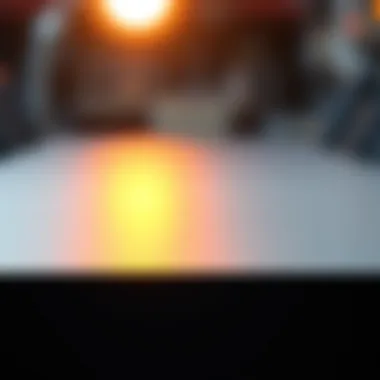
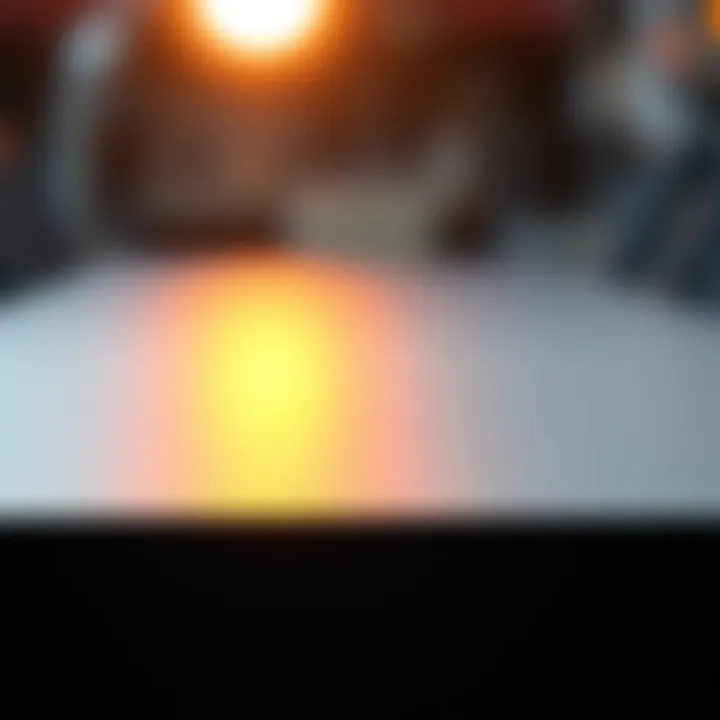
By weighing these components—accuracy and precision, cost, and scalability—manufacturers can choose the best method for their specific surface finish needs. This comparative analysis lays the groundwork for understanding which measurement strategies yield the best results in a given context.
For deeper insight, consider visiting resources such as:
- Wikipedia on Surface Finish Measurement
- Science Direct's articles on Measurement Techniques
- ResearchGate for academic papers
Industry Applications of Surface Finish Measurement
Understanding the various applications of surface finish measurement is crucial for multiple industries that depend on precision and reliability. Surface finish can significantly affect the performance, durability, and aesthetics of a product. This section will delve into the distinct sectors where surface finish measurement plays a pivotal role, emphasizing its significance and the benefits derived from meticulous assessment.
Aerospace Engineering
In aerospace engineering, surface finish measurement is not just a checkbox on a quality control list; it is a fundamental aspect that can determine the success of a mission. Components used in aircraft and spacecraft must meet stringent surface finish criteria to ensure safety and performance. For instance, irregularities on the surface can lead to increased aerodynamic drag, which may affect fuel efficiency.
Engineers often utilize sophisticated methods such as laser scanning and profilometry to gauge surface roughness in parts like wings, fuselage, and engine components. These measurements are crucial because even minute deviations can lead to catastrophic failures in flight.
"A smooth finish on a turbine blade can be the difference between a successful launch and a costly mishap."
In addition to safety concerns, surface finish impacts the ability to paint and coat parts. An uneven surface may lead to poor adhesion, resulting in corrosion and other failures down the line. Thus, the practice of measuring surface finish isn’t just about meeting specifications; it's about preserving human lives and maintaining technological advances.
Automotive Manufacturing
Automotive manufacturing is another sector where the measurement of surface finish bears significant weight. Car manufacturers invest heavily in the precision of every component. Elements such as engine parts, body panels, and even interior fittings require careful finishing to achieve optimal performance and consumer satisfaction. A rough surface may lead not only to more wear and tear but also to noise and vibration during operation.
In this industry, using contact-based methods like stylus profilometry and non-contact techniques like optical interferometry allows manufacturers to ensure their standards are met. The goal is to create components that enhance the performance of the vehicle while also appealing to consumers visually. A shiny, smooth surface is often equated with quality, directly influencing customers' purchasing decisions.
Moreover, the regulatory standards for emissions and noise control further emphasize the importance of surface finish. Ensuring components are manufactured with optimal surface finish improves aerodynamics and reduces friction, contributing to better fuel economy and lower emissions.
Electronics and Semiconductor Industries
Within the electronics and semiconductor industries, the demand for precise surface finish measurement is paramount for the production of devices such as microchips and printed circuit boards. Here, the technology that underpins our modern lives hinges on the minute details that surface finish measurements provide. Any imperfections in the surface finish can lead to electrical failures, short circuits, and overall product unreliability.
Surface finishes must be carefully controlled to allow for effective soldering and bonding of components. Nanometer-level measurements are not unusual in this industry. As semiconductors shrink in size, ensuring a flawless surface finish becomes ever more critical. Low-tech methods simply don't suffice for this level of accuracy. Hence, industries rely on advanced techniques, such as atomic force microscopy, to deliver results consistent with high-stakes performance standards.
Additionally, with the continuous push towards miniaturization, manufacturers are constantly developing new methods to assess and enhance surface finish. Not only does this improve the reliability of the devices, but it also paves the way for innovation in product design and functionality.
Understanding industry applications of surface finish measurement is essential for professionals in various sectors, linking technical precision with performance and reliability in real-world scenarios. It’s not just a matter of aesthetics; it’s the backbone of quality assurance that ultimately supports the technology shaping our world.
Future Trends in Surface Finish Measurement
Emerging Technologies
The future of surface finish measurement is brightened by various emerging technologies making waves across different sectors. Innovations such as advanced optical measurement systems, which can capture surface details at unprecedented resolutions, are becoming increasingly prevalent. These systems employ cutting-edge methods like multidirectional laser surface profiling, leading to more comprehensive data analysis.
Additionally, 3D printing techniques are being integrated into measurement processes, enabling real-time adjustments based on live data feed of surface finishes. This adaptability can revolutionize how surface finish specifications are enforced and evaluated, granting engineers a more precise gauge on quality.
Using Big Data analytics is another stirring trend. With vast amounts of data generated in manufacturing, the powers of analytics allow for better forecasting and machine learning implementations that predict surface finish outcomes based on historical performance. Consequently, it paves the way for proactive quality control measures, reducing defects before they even occur.
Integration with Robotics and AI
The fusion of robotics and artificial intelligence into surface finish measurement is an intriguing avenue currently unfolding. The utilization of automated systems enables more consistent and thorough inspections. Robots equipped with sophisticated sensors can navigate complex geometries, ensuring that measurements are conducted in a uniform manner. This removes the variability often seen with human-operated systems.
On another note, artificial intelligence supports faster data processing and decision-making. By employing machine learning algorithms, AI systems can analyze surface finish data, identifying patterns and anomalies that may not be readily visible to human inspectors. This enhances the precision of quality assessments, leading to improved product lifecycle management.
"The integration of AI into measurement techniques is not merely augmenting precision but is redefining the quality assurance landscape in manufacturing."
As we chart these future trends, the implications and potential benefits for industries cannot be ignored. This shift towards embracing technology promises not only to enhance measurement accuracy but also to set new benchmarks in product quality and innovation, leading to greater overall efficiency in manufacturing processes.
Finales
The exploration of methods for measuring surface finish reveals the profound impact such measurements have on various industries. The findings highlight both traditional and modern techniques that assist in ensuring the quality and performance of manufactured products. The intrinsic relationship between surface finish characteristics and overall product effectiveness cannot be overstated. Engineers and manufacturers must weigh the techniques at their disposal and select those best suited to the requirements of their projects.
Summary of Findings
Throughout this article, we found that the measurement of surface finish is crucial in determining how materials will perform in real-world applications. The following points summarize the critical insights:
- Different measurement techniques cater to distinct needs and characteristics, with contact-based methods like stylus profilometry providing detailed surface profiles, while non-contact techniques like laser scanning microscopy offer quick and less invasive alternatives.
- Accuracy and precision play pivotal roles in method selection, as even minor deviations can significantly affect final product quality.
- Cost implications are also a significant factor, as businesses strive to balance between acquiring high-end equipment and ensuring adequate measuring capabilities.
In industries such as aerospace and automotive, where safety and reliability are paramount, the methodology chosen for surface finish measurement directly influences product success.
Implications for Future Research
Research in surface finish measurement is not stagnant; it continues to evolve with technological advancements. Here are some considerations for future exploration:
- Integration of Artificial Intelligence: As AI technologies advance, they can improve the analysis of surface textures and assist in predicting material performance based on specific finishes.
- Development of Hybrid Techniques: Combining different measurement methods may yield more comprehensive insights, allowing for a better understanding of complex surface characteristics.
- Emerging Materials and Coatings: Future studies could focus on how new materials respond to various finish measurements, especially as applied in fields like nanotechnology and biotechnology.



